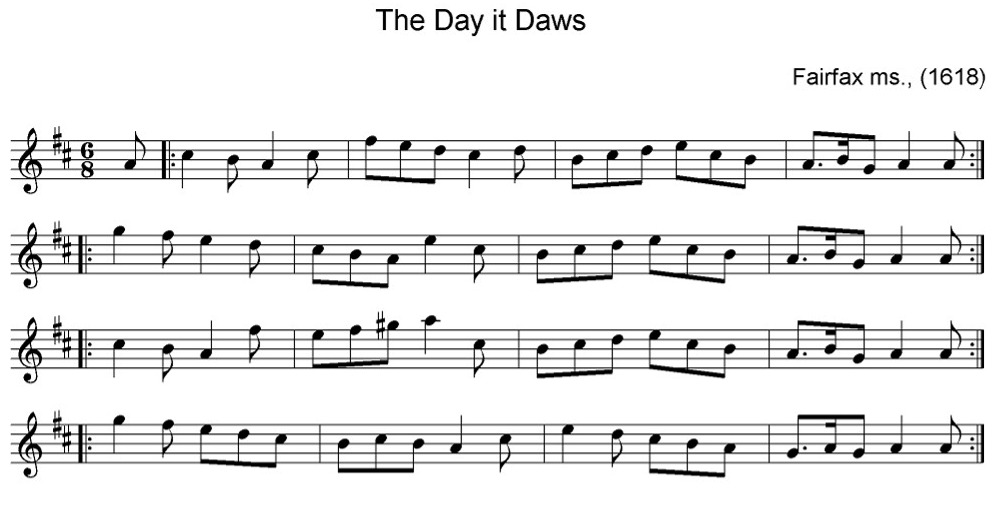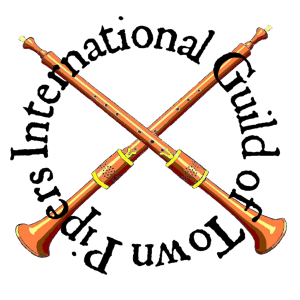Edinburgh Waits
Here are a few short notes on the Waites of Edinburgh – plus some links to other parts of this website where Edinburgh Waits are mentioned.
The office of town piper was revived in 1660 with the appointment of John Johnstone “to accompany the town’s drummer throw the town morning and evening”, paying him his salary and livery as in former years. From: “The Bagpipe” by Francis M. Collinson, Routledge (1975).
22 Dec 2010
The Scottish poet William Dunbar (1465-1530) complained that the Edinburgh waits could play only two tunes, ‘Into June’ and ‘The Day Dawns’. I attach midi and pdf files of the second, aka “Hey Now the Day Daws” for the section on tunes played by waits. I’m seeking the other piece.

Click image to zoom.
Sound File: Hey Now the Day Daws
The second item [see below] is a transcript of a typescript given to Richard Rastall several decades ago by Lyndesay G Langwill, on the Waits of Edinburgh. The Langwill article on Waits already on the website cites an item on the Edinburgh Waits that he published in “The Scotsman” in the 1930s, and this is probably the very same.
Alan Radford
Is this tune identified incorrectly?
I found the tune ‘Hey Tutti Tatti’ is labelled as the music for the Day it Daws. I am totally convinced that this is wrong. The error was first identified Frank Kidson back in the early 1900’s, and he blames Stenhouse; the real tune is buried in the [more or less contemporary with Dunbar] Fairfax manuscript song ‘The Day It Dawes’. A discussion of the music and a performable version of the waits tune is in my ‘The Day It Daws’. I’ve attached the tune here.
Pete Stewart
22 May 2011

The Fairfax ms. dates no later than 1618. As for “Hey now the day daws”, my source is Lewis Winstock’s “Songs and Marches of the Roundheads and Cavaliers”. However, I can’t recall what if anything he said of its provenance.
Alan Radford
23 May 2011
Why not link to Pete Stewart’s book The Day it Daws?
There’s also Jack Campin: If you haven’t explored his site, now’s as good a time … We ought at least to have a link to his CD-ROM Embro, Embro. It seems we have no links to Jack or Edinburgh, which is tantamount to iniquitous. [N.B. Al]
Dr James Merryweather
The CD ROMs produced by Nick Parkes are a great resource for Scottish music. Titles include James Oswald’s “Curious Collection of Scots Tunes” (Vol 1. 1740 & Vol 2. 1742) and James Oswald’s Caledonian Pocket Companion (books 1 to 12, circa 1745-1760). (Nick Parkes is one of the City of Lincoln Waites.)
Al Garrod
The Waits of Edinburgh
Lyndesay G. Langwill
From a typescript given by the author to Richard Rastall; possibly the article submitted to The Scotsman and published on 21 December 1932.
With the approach of Christmas we are afforded many reminders of the Waits, those municipal servants of the past, musicians who served their day and generation and through six centuries held office in our towns by virtue of charters or statutes. The origin of the name, from the Anglo-Saxon ‘wacian’, to watch or guard, shows the primary duty of these watchmen-musicians. The Norman-French could not pronounce the ‘w’, with the result that the forms ‘Guet’ and ‘Gaite’ gave rise to such expressions as ‘bon-gaite’, a morning salutation. The English occupational surnames Gait, and later Wait, Wakeman etc., also resulted. Watchmen termed ‘waytes’ were established in London and elsewhere by order of Henry III (1216-72) and Edward III (1327-77) had three ‘wayghtes’ in his Royal Music. Edward IV (1461-83) had elaborate instructions for his Household Waytes and the Liber Niger Domus Regis refers to “a wayte that nightly from Michelmas to Shreve Thorsdaye pipeth the watch within this Courte foure tymes, in the somere nyghtes III tymes and makyth bon gaite at every chamber door and offyce as well for fear of pickers and pillers”.
The first volume of Extracts from the Edinburgh Burgh Records (1589-1603) makes mention of a scheme for Town Musicians – “schalmes howboyes and siclyk” – but the proposal took no effect. On 30th January 1607, however, John Orley was appointed by the Magistrates and Council to serve the town “in his calling and with the musicall instruments of schalmes, howboyes and siclyk be himselff and four expert musicianes quhilk he sall furneis upon his charges”. They were to traverse the town “Cowgaitt and all” every day at noon “to blaw and play ane certaine spaice upon any pairt of the stepill the baillies plesis” and between six and seven in the evening “betwix the Castelhill and Netherbow”. An act of 15 June 1608, orders payment to be made for the mould of the silver badges for JohnOrley and his four companions. For two centuries the “schalme” or shawm – the primitive form of the French hautbois or Scots howboyes – was the principal instrument performing “the town’s music”.
The Council Records of 31 October 1679 grants warrant to James Smith, music-master in the Canongate and his servants “to play everie morning (excepting the Saboth) throwth the city as waitts upon ther Cornets and uther instruments”. The Treasurer was also authorised to furnish “coats in the touns liverie and appoynt ther master to….play constantly throw the streets and vennels each morning excepting as said .. from the first of November to the first of March nixt”. The payment for this service was £5 sterling.
The livery of the Waits was gorgeous in many English towns. Those of London at the end of the 16th century wore “blue gowns, red sleeves and caps, every one having his silver collar about his neck”. The Edinburgh Records of 7 November 1694 appointed “John Swanstoun to be principall waite”, and he and his four companions were ordered each “a gray cloak with black and whyte lace as the touns livery to be worne only within the Toun”. It is much to be regretted that we have no pictorial record of these waits. The City of Norwich is fortunate in possessing two of the “silver collars” dating from 1535 constituting the Waits’ chains and badges, and similar curios are preserved at Bristol, Beverley, Wakefield and Stamford.
A feature suggestive of the “signature tunes” of modern days was the Wait-Tune. Each group had its particular melody and we have several of these still preserved to us, e.g. “London Waits” (two versions), “Tower Hamlets” and “York Waits” both hornpipes – Stamford Waits, Warrington Waits – a charming little minuet – and Oxford Waits, a gavotte.
The association of the term Waits with itinerant musicians of a very inferior order is most unjustified for the medieval Waits were highly-skilled musicians. In Germany they constituted the ‘Stadtpfeiferei’ – guilds which furnished many celebrated musicians. Johann Sebastian Bach was the son of a Stadtpfeifer, and in England Orlando Gibbons was the son of a Cambridge Wait, and his brother Ferdinando was a Lincoln Wait. Evidence of a test of musicianship is afforded by the Edinburgh Records of 17 April 1696, where John Monroe and Malcolme McGibbone were appointed players on “the French hautboyes and double curtle” being found “compleat masters of playing upon the said…instruments”, which were considered far more proper for the town’s waits than the instruments they now play upon. The Waits varied in number from nine as in London to four as in Edinburgh “or five at the most who shall all be obliged to play upon the French hautboyes one always playing on the double curtle for the bass”. An interesting sidelight is afforded by the decision “that the said Malcolm McGibbone be allowed to keep a schooll within the town to teach that sort of musick and be allowed to play to gentlemen at seasonable tymes when imployed”. The double curtle, which was evidently McGibbon’s instrument, was the Scots designation for the curtal, (Fr. Courtaut), as the Bassoon was known from the close of the 16th century until the middle of the 18th century. Each Wait had often an apprentice, and these pupils were strictly examined before admission as Waits.
In 1701 the Edinburgh Waits petitioned the Council for new liveries, with the result that “Gilbert Somervell present deacon of the Taylors” was appointed “to cause provyde the petitioners cloaks and other furniture therto belonging”.
A century passes apparently uneventfully, unless perchance the waits became less and less appreciated in a period of considerable social development. James McGlashan was the last Wait to have his appointment recorded – in 1800 – and although a petition by “the Cities Wakes” for increased remuneration was granted by the Council on 15th February 1804 we may surmise that their office did not survive long. Indeed a study of the meagre extracts relating to the Waits in English towns shows that the dawn of the 19th century, which was to bring such revolutionary developments in wind instruments of both wood and brass, saw the passing in Scotland of a class of time-honoured musicians. The English Church-bands of the first half of last century indeed offered an opportunity which might have kept the Waits with us in another capacity. Thomas Hardy in “Under the Greenwood Tree” has given a charming picture of this period, which, however, was brought to a conclusion with the introduction of the organ. In Scotland, the precentor with pitch pipe or fork, brooked no interference from meddling musicians, however competent, and since much has been written concerning this phase of our national musical life, let us hope that the records of other Scottish cities may yet throw much light upon those Waits, whose simple music-making charmed our forefathers three hundred years and more ago.
Another little fact about the Edinburgh Waits.
“The Edinburgh Waits still employed a trombonist in 1675.”
From “The Trombone” by Trevor Herbert, Yale University Press (2006).
Alan Radford
23 May 2011
ElectricScotland.com
“In Edinburgh in 107 A.D. [date typo] there were three town pipers, who were paid three pence daily; one of their duties was “to accompany the toun’s drummer throw toun morning and evening.”
http://www.electricscotland.com/history/scotreg/pipesofwar02.htm
EDINBURGH
From Alan Radford, 23 Feb 2015. A few more snippets for Historical records below – from Jack Campin’s website.
1555 ‘The bailies and counsale ordanis thesaurer Maister John Prestoun to content and pay to James Dromond and his marrowis quha plait befoir Sanct Geill on Sanct Geillis day on the schammes the sowme of xls.’
1607 Town Waits to play at noon from the steeple of St. Giles and in the evening around the town. They played “schalmes and howboys and siclyk.” [shawms, oboes and suchlike]
1679 they played cornetts and other instruments
1696 they has “French hautboyes, one allwayes playing upon the double curtle for the bass”. The curtal player was Malcolm McGibbone. His fellow wait John Monroe was also found to be a “compleat master of these instruments. McGibbon also played flute, oboe and violin.
1804 the last record of a wait, this concerning him drawing a salary.
